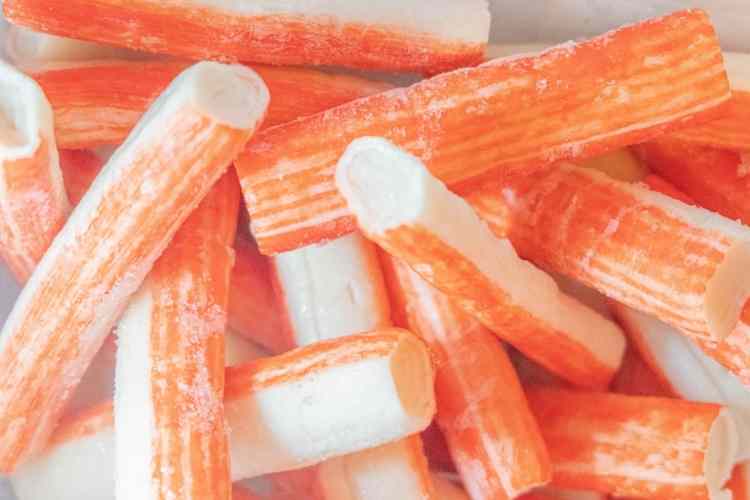Imitation crab is the substitute of crab that has gained popularity in recent decades and can be found in seafood salads, crab cakes, California sushi rolls, and crab rangoons. In a nutshell, imitation crab is processed fish meat, also known as “the hot dog of the sea”. However, you might be curious as to what it’s comprised of and whether or not it’s nutritious. In this blog we are going to tell you Health Benefits Of Imitation Crab, so read this blog carefully to know more.
About Imitation Crab
Surimi-fish flesh that has been deboned, washed to remove fat and undesirable pieces, and minced into a paste is used to make imitation crab. This paste is mixed with additional ingredients, then cooked and squeezed into crab meat-like shapes. While imitation crab is created from seafood, it usually does not contain any crab, except a little quantity of crab extract added for flavor.
Surimi is made with pollock, which has a mild flavor and color. Fish sticks and other breaded fish products are also made using this fish. Packages containing crab-like items may be called “imitation crab”, “crab-flavored seafood,” or “surimi seafood”, but they must still adhere to regulatory labeling guidelines. Surimi-based seafood is known as Kamaboko in Japan. Imitation crab may be spelled “krab” on restaurant menus to signify that it is fake.
Related: Health Benefits Of Okra
Ingredients in Imitation Crab
Surimi is the principal ingredient in imitation crab, accounting for 35% to 50% of the total weight of the product. Here are some other major ingredients of imitation crab.
• Water – water is the second most abundant ingredient in imitation crab, and it is required to provide the desired texture and keep costs down.
• Starch– Potato, wheat, corn, and tapioca starch are commonly used to firm up surimi and make it freezer-friendly. However, if too much starch is utilized to save money. The result would become sticky and soft.
• Protein– The most frequent source is egg white protein, however other proteins, such as soy, can also be used. These improve the texture, color, and glossiness of imitation crab by increasing the protein content.
• Sugar and sorbitol – two ingredients assist the product to withstand freezing and thawing. They also add a touch of sweetness.
• Vegetable oil– sunflower, soybean, or other vegetable oils may be used to improve the texture, white color, and shelf life of the product.
• Salt (Sodium Chloride)- in addition to imparting flavor, salt aids in the formation of a firm gel from the minced fish. Some of the salt can be replaced with potassium chloride which fulfills the same duties.
Related: Health Benefits And Side Effects Of Iyana Ipaja Leaf
Health benefits of Imitation crab
• Calories, fat, and cholesterol
Imitation crab is low in calories and fat, so it’s a good addition to your diet if you are watching your weight or trying to lose weight. Choosing low-calorie, low-fat foods is also a good approach to avoid chronic illnesses like heart disease. Imitation crab meat has 81 calories and less than 1 gram of fat per 3-ounce serving. Imitation crab has 17 milligrams of cholesterol per serving, making it a good choice for those on a low-cholesterol diet.
• Sodium
The amount of salt in imitation crab meat is the main nutritional disadvantage. A high-salt diet raises your risk of renal disease, stroke, and high blood pressure. The sodium content of a 3-ounce portion of imitation crab meat is 715 milligrams.
• Phosphorus
Imitation crab meat has a good amount of phosphorus in it. Phosphorus makes up 1% of your body weight and is found in every area of your body, with the majority of it in your teeth and bones. Phosphorus is necessary for the efficient function of your kidneys and muscles, as well as the health of your bones and teeth. It also supports healthy nerve function and maintains your heart beating regularly. Each day, you require 700 mg of phosphorus, and 3-ounce of imitation crab flesh provides 240 mg.
Related: Health Benefits Of Ocimum Sanctum
The last words
Incorporate imitation crab bits into a tossed green salad or a seafood stew or pot vegetable soup to get the benefits of its nutrition. To make a tasty sandwich filling, combine imitation crab meat, low-fat mayonnaise, and fresh herbs. To make a dip to serve with fresh veggies or whole-wheat crackers, mix diced imitation crab meat into a carton of low-fat sour cream, then season with pepper and fresh herbs. To keep your sodium consumption low, keep your serving sizes small.In last, I hope this blog is sufficient enough to provide the information about the Health Benefits Of Imitation Crab.

